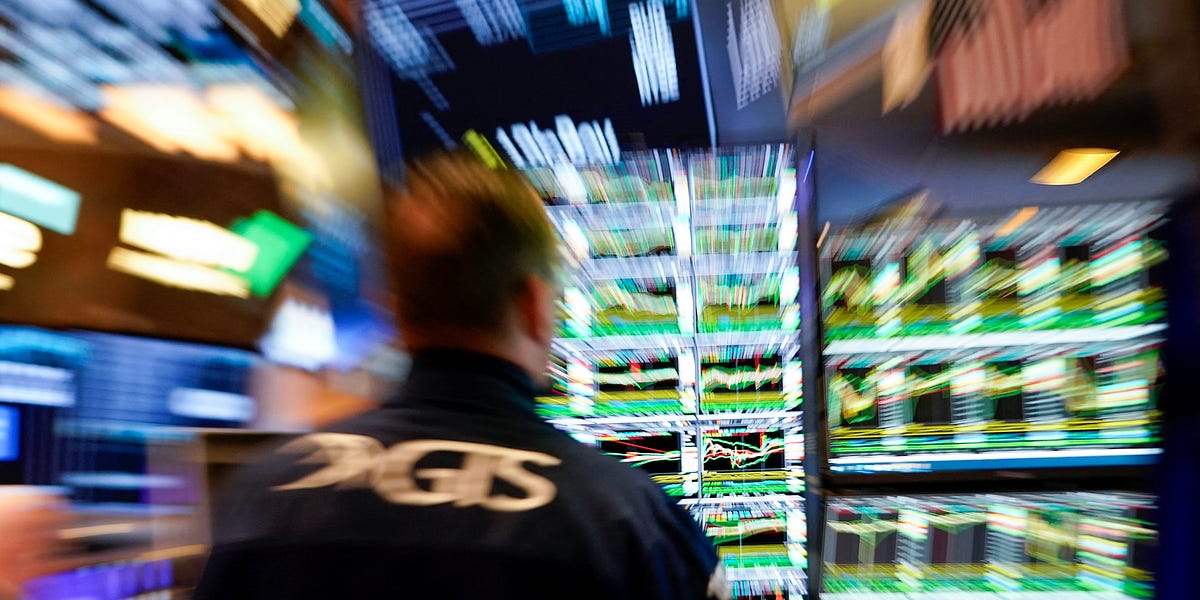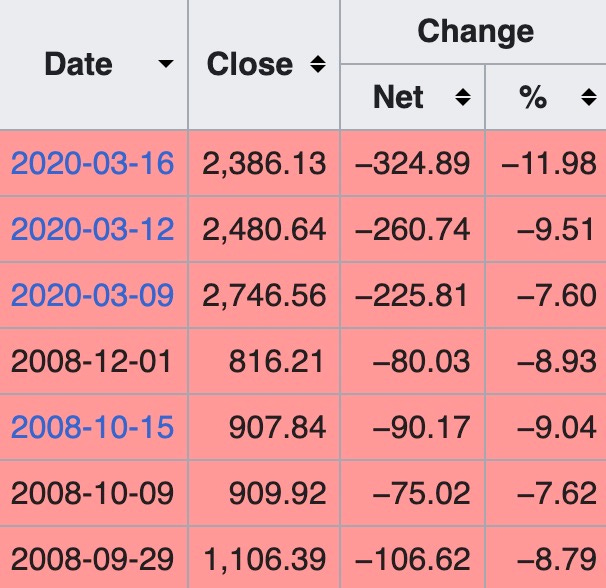Follow the Money

Hey guys, I’m sending out Monday’s Triad on Sunday night for reasons that will be clear when you read it. So you won’t get another Triad in your inbox on Monday—but keep your eyes on the Bulwark homepage, YouTube channel, and podcasts. The team is doing great work making sense of the Trump tumult. –JVL

1. Stop Loss
When the New York Stock Exchange opens on Monday at 9:30 a.m. we will see just how seriously the world takes the assault Elon Musk and Donald Trump launched on the American system of government.
What follows is a guide for interpreting the drop.
First, some ground rules. The securities markets have a system of circuit breakers to halt massive declines. There are three circuit breakers that are measured by calculating a percentage decline in the S&P 500 from the close of the previous day: Level 1 (7 percent), Level 2 (13 percent), and Level 3 (20 percent). If Levels 1 or 2 are tripped before 3:25 p.m., all trading is halted for 15 minutes. If Level 3 is tripped at any point in the day, trading is halted for the remainder of the day.
Last Friday the S&P closed at $6,041. Trading ended at 4:00 p.m., per the norm, but at 1:15 p.m. a selloff started when reports of Trump’s proposed tariffs against Canada and Mexico hit the wires. In less than three hours, the S&P lost 1.1 percent from its daily high.
Here are the S&P’s circuit breaker numbers for Monday:
- Level 1: $5,617
- Level 2: $5,255
- Level 3: $4,832
For context, since 2008 we have only had seven S&P drops greater than 7.6 percent in a single day:

The two worst of these were in March 2020 as the markets began to grasp the full ramifications of COVID. The other drops all took place at the opening of the 2008 financial crisis.
So those are the kinds of events that trigger large-scale panic in the markets: global pandemics and global financial meltdowns.
Will Monday’s pullback register on those magnitudes? Or will it be more modest and hold under 7 percent?
2. Tea Leaves
The answer to that question will tell us what the markets believe about Musk’s and Trump’s intentions. Here are four scenarios:
(1) Drop is < 5 percent: The markets do not believe that Trump’s tariffs on Mexico and Canada are likely to remain in place. Nor are they especially concerned by the reports of turmoil in Washington over the weekend. They basically believe everything is normal and that Trump will quickly revert to par, allowing the broader economy to continue more or less as normal.
(2) Drop is 5 percent to 7 percent: The markets are concerned that Trump’s tariffs will impact the American economy in the near term and that this movement could trigger broader recessionary risks. They believe that Trump might be responsive to market pressure, but they aren’t sold on this hope.
The markets are focusing all of their attention on the tariffs—trying to divine how long they’ll be in place and what the magnitude of the damage will be. They haven’t begun to process what went down at Treasury over the weekend.
(3) Drop is 7 percent to 9 percent: The markets are spooked. It’s not a full-blown panic, but no one knows which end is up or what the exit strategy might be. The fear is that tariffs have opened a Pandora’s box that, combined with instability in Europe and the increased potential for instability in Asia, raises the possibility that things could get really bad.
Though no one is ready to start speculating on just what the land of bad might look like.
(4) Drop is > 9 percent: A selloff of this magnitude would suggest absolute panic at the worst level in living memory. (Other than COVID and the 2008 financial crisis, you’d have to go back to the crash of 1987 to find an analogue.)
At this level, the market is signaling that it has no confidence in the near-to-medium-term American economy and cannot even begin to price the tail risk.
I can’t tell you what the market is going to say, because I don’t know how quickly it’s able to assimilate reality. What I can tell you is this: If we’re at scenarios #1 or #2, it means that the world does not understand political reality in America yet.
Because the reality is that tariffs are the least of our problems.
Tariffs are just a policy.1 A stupid policy, perhaps. A costly policy for certain. But they are legal. There is ample precedent for them. They can be turned on or off quickly; course correction is as close to instantaneous as it gets for a nation-state. And nothing about tariffs impacts the underlying economic position of the United States. At worst, they increase inflation and suppress growth; maybe even spark a recession.
Inflation, slow growth, and recessions are painful, but recoverable. We’ve seen them before. We will see them again, irrespective of what happens with these tariffs.
The real danger is what we saw at the FBI and Treasury this weekend—because those actions strike at the heart of the economic order.
Some concerns:
The FBI. The Trump administration’s decapitation of the FBI cannot be read as anything other than a declaration that federal law enforcement is now entirely a political operation.
Musk’s takeover of the Treasury payment system. Elon Musk allegedly has control of the system the U.S. government uses to disburse congressionally mandated payments. Further, Musk claims that he, personally, is putting a stop to payments that he does not like.
First: This obviously could not happen unless the FBI had been neutered, because these actions are badly illegal. Of course, if the DoJ and FBI refuse to investigate the crimes, then are they really crimes at all?2
Second: If Musk is personally deciding what money comes out of the Treasury, then it is impossible to predict where economic disruptions will hit. Will Musk stop payments to social services vendors in South Dakota? Or to aerospace contractors in New Jersey? Will he refuse to make interest payments on government debt? Will he ratchet back Social Security disbursements? If you cannot predict government disbursements after laws have mandated them then you cannot predict the future economic environment.
The future of banking. If you wanted a real doomsday scenario, you’d start worrying about the future of the FDIC and ACH systems.
The FDIC is the program that guarantees the bank deposits of ordinary consumers. It was one of the most important New Deal reforms enacted to prevent another Great Depression—and it has been in the Musk/Trump crosshairs. If the FDIC is neutered, the rules surrounding capital requirements for banks would shift in ways that are impossible to anticipate, and could reshuffle the American banking system itself.
Even more concerning is the country’s ACH system.
The Automated Clearinghouse (ACH) is the utility system that routes and transfers most electronic funds in the United States. There is a federal component (the Federal ACH) and a smaller component run by a consortium of banks.
What if Musk is looking to disrupt the ACH system? Or more to the point: Replace it with his own, private system?
Here are some things we know:
- Musk recently declared that his company X will, in a year, be such a complete financial services hub that “you won’t need a bank account.”
- Over the weekend X.com became the exclusive platform used for external communication by the NTSB.
- Also over the weekend, Musk launched a series of lawsuits against private corporations for not advertising on X. His position seems to be that private companies should be compelled to buy advertising services from him.
- Musk’s forces allegedly have access to the Treasury’s federal payments system.
Does this sound to you like a situation that could potentially end with Musk attempting to disintermediate the ACH system and route all electronic transfers—including all transfers made by the federal government—through his private company?
Because that’s what it sounds like to me.
3. Paralysis
Once upon a time, whenever a bomb went off in the Middle East, oil prices would spike. It was a risk premium. Even though any individual bombing was unlikely to result in disruptions to oil production or shipping, there was always a risk that it might.
And because that risk was well understood, the markets would respond to it.
I am not so sure the markets are capable of understanding the level of risk we currently face. It’s too big and too novel. It’s beyond any of the participants in the markets’ ken.
Wars, financial crises, even pandemics. They all have precedents. We’ve seen them. We can understand what the dangers look like. We can put prices on the various risks.
I suspect that the markets do not quite understand the gravity of our situation because they have never seen anything like it in a first-world country. They have never witnessed a global hegemon attempt suicide.
If the markets understand the peril of America’s position at the moment, then tomorrow will be a (financial) bloodbath.
And if they don’t understand yet, they will eventually. Because when the old political and financial orders fall, someone is going to make a killing.
Take a minute to send this to a friend or family member, or post it to social media:
On Sunday, Trump said he would speak on Monday morning with Canadian Prime Minister Trudeau and “Mexico,” whoever that means. “I don’t expect anything very dramatic,” he said. The outcomes of those phone calls, though, could affect the markets.
Tesla’s stock price will tell us a lot about the market’s understanding of the rule of law in America.
Musk created a great deal of legal exposure for himself this weekend.
TSLA is largely owned by Musk and his leadership of the company is considered (by the market) to be absolutely critical. He has just placed himself in legal jeopardy. If the market believes that the rule of law in America is potentially still viable, then you would expect to see a massive drop in TSLA’s share price tomorrow due to uncertainty about Musk’s legal future and ability to lead the company.
If TSLA does not drop significantly, it means that the market does not believe there is any chance the rule of law will apply to Musk.
Source: View source



